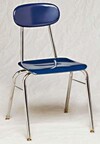All In Our Places: School Desks and the Persistence of Things
When I was a boy and my brother was a boy (I always began the stories I told my youngest goddaughter and her sister when they were little this way) . . . so, when I was a boy and my brother was a boy, I attended a crowded Catholic grammar school, as they were called then, in Bellflower.
In the second and third grades -- in 1955 and 1956 -- we sat in desks like those in the photograph below: open cast-iron frames supporting pairs of wood seats and desks, the pairs bolted together to planks on either side, the rows in formation and with just enough room between the rows to allow our teacher in her black nun's habit to pass, the dark wooden beads on her long rosary occasionally clicking against the edge of a desk.
The desk tops had an inkwell hole drilled into the upper right side, ringed with dark stains, and a routed groove along the top edge of the desk where a dip pen would have been laid if my earliest school days had been the turn of the century when these desks were new. I suppose those desks were all that the school and our parents could afford -- second-hand seating from a past in which inkwells and pen nibs and the risks of tripping over the slats on the floor were part of going to school.
The school buildings themselves were modern and less than ten years old, but the desks and how we sat in them were at least half a century older.
In the higher grades, we sat in desks like those in the next photograph: stamped and welded metal containers that combined a seat, backrest, desk, and a little storage area below. The metal parts were painted a kind of beige flesh color. Because each desk was a single unit, the rows of desks got ragged by the end of the day, all the pale desk tops not pointing in the same direction.
The desks, of course, were made for the right-handed. My brother -- one grade ahead of me and left handed -- struggled to make his handwriting legible sitting at a desk that misunderstood him.
A few years later, most of the desks at my Catholic high school were flimsy constructions of metal supports tied together with plywood elements, almost IKEA-like (as are the abandoned ones in the photograph below). The metal parts of those desks were painted (and repainted from time to time) a nameless color that combined gray and brown.
Students today mostly sit behind less constraining combinations of chairs and desks and in arrangements that rarely fall into rows. The inkwells are gone, but many millions of students still sit in the chairs their parents sat in -- often the very same chair.
The chairs are variants of the Columbia Manufacturing model 114 Super Stacker Chair. They're obviously durable, relatively low-cost, and forthrightly upright chairs. What six hours of sitting in one felt like might be the first thing a young adult forgets after graduation.

The steel and plastic and tamper-proof screws of the Columbia Manufacturing model 114 Super Stacker Chair -- just like the wood and cast iron of the desks in my grammar school classroom -- have a pedagogical reason. As the suppler of desks and chairs to New York City schools pointed out in a recent New York Times article:
They did not have solid plastic a hundred years ago, but the concept is the same," Bob Keller, the chairman of Nickerson Corporation, said of the Columbia chairs. . . . They are not made for comfort. They are made for students to sit up and for students to be working. They are what we call a straight-backed chair.
The desk I sat in when I was seven was an assemblage of expectations of what a pupil is and does. The desk and seat were formed into a design that spoke to its own past and tried to speak to my future. The desks through grammar school, high school, and college impressed their several expectations, a touch not often reflected on.
Did I inherit lower back pain or orthodox values by sitting in those upright chairs?
In the everyday, the persistence of things is part burden, part murmured dialog with a past that is unable to be entirely in the past. Time slipping is our common condition, and we're never wholly new.


